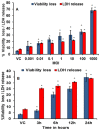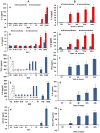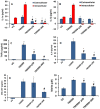Alveolar macrophage innate response to Mycobacterium immunogenum, the etiological agent of hypersensitivity pneumonitis: role of JNK and p38 MAPK pathways
- PMID: 24349452
- PMCID: PMC3859638
- DOI: 10.1371/journal.pone.0083172
Alveolar macrophage innate response to Mycobacterium immunogenum, the etiological agent of hypersensitivity pneumonitis: role of JNK and p38 MAPK pathways
Abstract
Mycobacterium immunogenum is an emerging pathogen of the immune-mediated lung disease hypersensitivity pneumonitis (HP) reported in machinists occupationally exposed to contaminated metal working fluid (MWF). However, the mechanism of its interaction with the host lung is unclear. Considering that alveolar macrophages play a central role in host defense in the exposed lung, understanding their interaction with the pathogen could provide initial insights into the underlying immunopathogenesis events and mechanisms. In the current study, M. immunogenum 700506, a predominant genotype isolated from HP-linked fluids, was shown to multiply intracellularly, induce proinflammatory mediators (TNF-α, IL-1α, IL-1β, IL-6, GM-CSF, NO) and cause cytotoxicity/cell death in the cultured murine alveolar macrophage cell line MH-S in a dose- and time-dependent manner. The responses were detected as early as 3h post-infection. Comparison of this and four additional genotypes of M. immunogenum (MJY-3, MJY-4, MJY-12, MJY-14) using an effective dose-time combination (100 MOI for 24h) showed these macrophage responses in the following order (albeit with some variations for individual response indicators). Inflammatory: MJY-3 ≥ 700506 > MJY-4 ≥ MJY-14 ≥ MJY-12; Cytotoxic: 700506 ≥ MJY-3 > MJY-4 ≥ MJY-12 ≥ MJY-14. In general, 700506 and MJY-3 showed a more aggressive response than other genotypes. Chemical blocking of either p38 or JNK inhibited the induction of proinflammatory mediators (cytokines, NO) by 700506. However, the cellular responses showed a somewhat opposite effect. This is the first report on M. immunogenum interactions with alveolar macrophages and on the identification of JNK- and p38- mediated signaling and its role in mediating the proinflammatory responses during these interactions.
Conflict of interest statement
Figures









References
-
- Rosenman KD (2009) Asthma, hypersensitivity pneumonitis and other respiratory diseases caused by metalworking fluids. Curr Opin Allergy Clin Immunol 9: 97–102. - PubMed
-
- Wilson RW, Steingrube VA, Böttger EC, Springer B, Brown-Elliott BA, et al. (2001) Mycobacterium immunogenum sp. nov., a novel species related to Mycobacterium abscessus and associated with clinical disease, pseudo-outbreaks and contaminated metalworking fluids: an international cooperative study on mycobacterial taxonomy. Int J Syst Evol Microbiol 51: 1751–64. - PubMed
Publication types
MeSH terms
Substances
Grants and funding
LinkOut - more resources
Full Text Sources
Other Literature Sources
Research Materials
Miscellaneous

